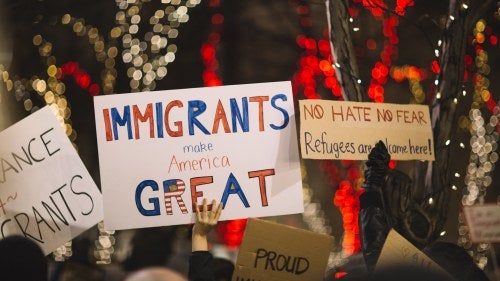The Indispensable Role of Cities in Migration Governance

As the historical gathering point of people from different origins, cities are a key nexus of immigration policy implementation and innovative experimentation.
On the national level, migrant and refugee issues have roiled the politics of one country after another. But the tenor of migration politics differs across scales of government. There are promising developments at both the global and subnational levels – and cities are taking on an active role in migration policy discussions.
At the global level, UN member-states are in the process of finalizing two international agreements – the Global Compact on Refugees, and the Global Compact for Safe, Orderly, and Regular Migration – which are to be adopted in the latter part of 2018. While the Compact on Refugees relies heavily on existing treaty commitments, the Migration Compact breaks new ground in setting forth new forms of international cooperation on migration, an issue area that has traditionally been the sole right of national governments.1
In December 2017, the Trump Administration announced that the United States was withdrawing from the Global Compact for Migration with the spurious assertion that the Compact, which is nonbinding, would undermine the country’s sovereignty. But – just as with the implementation of the Paris Climate Agreement – US cities are stepping forward where the federal government has stepped away. Los Angeles, New York, Chicago, Atlanta, and many other cities across the globe have called for a consultative role in UN discussions on the Compact. Cities, together with civil society organizations and nongovernmental policy experts, are providing an ongoing presence for the United States in the international migration policy arena.
It makes sense. Cities are where migrants, refugees and asylum-seekers come face-to-face with the economy, social services, and law enforcement. Most of the world’s economic migrants live in cities, as do the majority of refugees and internally displaced persons. The Global Compact for Migration calls for many policy measures that can only be enacted at the national level, such as safeguards for the human rights of migrants and policies for the cross-border portability of social security entitlements. But other measures called for by the Global Compact, such as promoting integration and providing access to basic services for migrants, will ultimately be carried out by local governments.
Marvin Rees, the mayor of Bristol, UK — and the son of Jamaican immigrants — is a scheduled speaker at this year’s Chicago Forum on Global Cities. In a recent interview with The Guardian, Rees summarized the indispensable role of cities in international migration policy debate: “If cities have a place at the table when discussing things like migration, you’ll get a different kind of discussion. The nature of citizenship and belonging in a city is subtly but importantly different [than] the nature of citizenship and belonging in a country.”
In general, city governments tend to be much more pro-immigrant in orientation than their national counterpoints. Immigrants and refugees are increasingly recognized as an important part of the economic vitality of cities – a point forcefully expressed several years ago by the Chicago Council’s Midwest Immigration Task Force. Not every urban administration welcomes migrants and refugees, but unlike national and state/provincial governments, they are informed by the generally more cosmopolitan, pro-immigrant preferences of city-dwellers, undiluted by the views of rural voters.
Cities are learning from each other. Municipal governments and policy experts exchange information and share good practices on incorporating migrants and refugees through a growing array of specialized consortia and platforms, such as the International Metropolis Conference (held annually since 1996), the Toronto-based Cities of Migration project, and the Mediterranean City-to-City Migration initiative. The annual Mayoral Forum on Mobility, Migration, and Development, whose inaugural meeting took place in Barcelona in 2014, helps city leaders from around the world directly engage with relevant UN agencies. The Barcelona Centre for International Affairs (CIDOB) examines this sort of “international municipalism” as a key focus of its new Global Cities Program.
General-purpose international urban networks are also focusing significant attention on migrants, asylum-seekers and refugees. Regional platforms include the Council of Europe’s Intercultural Cities program, which aims to help cities manage – and benefit from – cultural diversity, and Eurocities, a network of more than 140 European municipalities that advances mutual learning on migrant integration. On the global scale, an emphasis on equal access to services – regardless of migration status – is woven throughout the UN’s New Urban Agenda.
In the United States, large municipalities are often portrayed as playing a purely defensive role in this arena, as in the controversy over “sanctuary cities.” But cities in fact provide an essential, pragmatic ground-truthing for immigration policy. Historically the gathering point for people from different origins, cities are a key nexus of migration policy implementation, and a source of innovative thinking and policy experimentation. Cities have their problems and pathologies, but at their best, they point the way toward a society that truly welcomes the stranger. As international negotiations on migration governance continue, cities should be encouraged to play a bigger role in shaping global commitments and their implementation.

